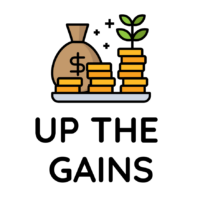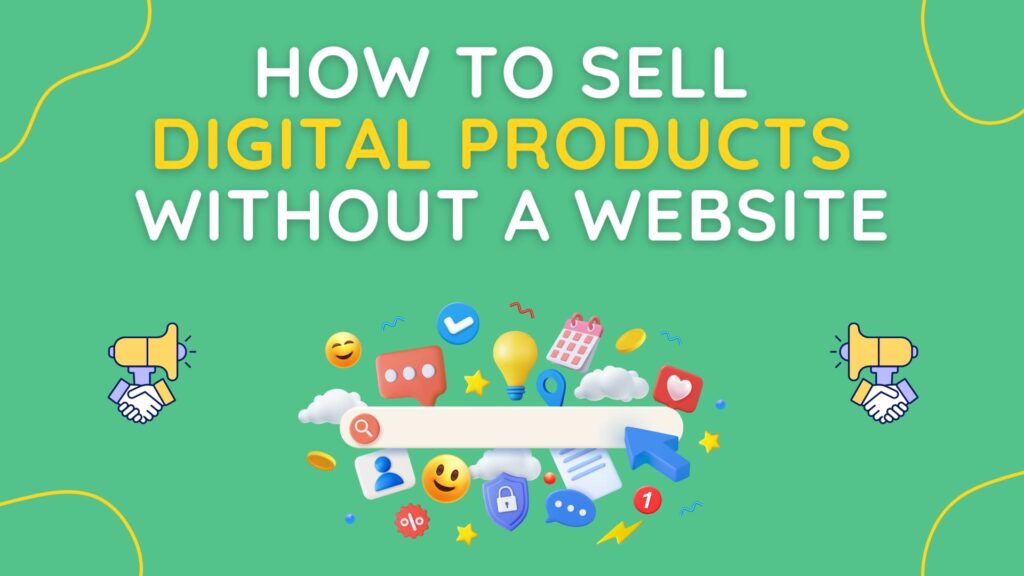
Sammie Ellard-King
I’m Sammie, a money expert and business owner passionate about helping you take control of your wallet. My mission with Up the Gains is to create a safe space to help improve your finances, cut your costs and make you feel good while doing it.
In today’s digital age, selling digital products or digital downloads as they’re also known has become an increasingly popular and lucrative business venture.
In this article, we’ll explore the advantages and disadvantages of selling digital products, as well as provide a step-by-step guide on how to sell them without the need for a website.
From identifying your target audience to utilising social media and email marketing, we’ll cover everything you need to know to successfully sell digital products in the online marketplace.
So, whether you’re a seasoned entrepreneur or a budding business owner, read on to discover how you can harness the power of digital products to boost your sales and grow your business (without the need of a website).
Table of Contents
How To Sell Digital Products Without A Website?
Selling digital products without a website is achievable through various platforms that offer payment integration, social media promotion and simplified storefront creation, allowing creators and online businesses to reach their target audience without the need for traditional website building.
Learning how to create digital products these days can be as easy as watching a YouTube video and having a decent Canva template
There are so many different way to sell digital products online without a website so below I’ve listed the best platforms to sell digital products on and some top strategies too – feel free to click to whatever one takes your fancy or read them all!
Here are the topics we’re going to cover:
Sell digital products through online marketplaces
Selling digital products through 3rd party websites
Sell digital products through email marketing
Sell digital products through course platforms
Sell digital products through Instagram
Sell digital products through Facebook groups
Sell digital products through TikTok
Sell digital products through YouTube
Join over 1,000 others learning how to go from £0-5k with just 60 minutes work a day.
Includes everything you need to create, build and sell profitable digital products in a niche you're already passionate about.
Sell digital products through online marketplaces
To sell digital products via online marketplaces you’re essentially capitalising on a brand that already has organic visitors. These are usually buyers with intent looking to make a purchase.
Some of the largest online marketplaces that we all know are Amazon and Etsy. They’re probably the two largest sellers of digital products in the world.
But, then around this you have 100s of smaller online marketplaces that function in the same way but may be more targeted to a certain topic or industry.
That’s why when you pick a marketplace to sell digital product on you need to understand the audience which is going there and what they’re truly looking for.
Sure, Amazon and Etsy have millions of categories but is your particular niche likely to hang out on there?
When you select a marketplace you will need to create listings, pricing, write sales copy and upload imagery. It’s also important to think of keywords that people would be searching for too and include those in titles and/or product descriptions.
Optimising your listings is key to a successful product as the more you sell and the more time people spend on your listings they more these marketplaces will push your products. This is especially useful if you have competitors in the space selling something similar.
Here are some of the key pros and cons of selling digital products via online marketplaces:
Advantages
Wide Audience Reach: Online marketplaces like Amazon, Etsy, and eBay have vast, established audiences. This exposure can significantly increase the visibility of your digital products to potential buyers worldwide.
Ease of Use: These platforms often provide user-friendly interfaces, making it easier to list and manage products. For sellers without technical expertise, this is a considerable advantage.
Built-In Trust: Established marketplaces have built-in trust with consumers, which can lend credibility to your products. Customers might be more willing to purchase from a known platform than an independent website.
Integrated Payment Systems: These platforms handle all aspects of the transaction, including secure payment processing, which can simplify the selling process.
Marketing Tools: Many online marketplaces offer marketing tools and analytics, helping sellers target their audience effectively and understand their buying behavior.
Disadvantages
Fees and Commissions: Most online marketplaces charge fees or take a commission on sales. These costs can cut into profit margins, especially for lower-priced products.
Competition: The presence of numerous sellers on these platforms can lead to high competition, making it challenging to stand out.
Limited Customisation: Marketplaces typically offer limited options for personalising your storefront or product listings, restricting how you can brand and present your products.
Dependence on Platform Policies: Sellers are subject to the rules and policies of the marketplace, which can change and impact your ability to sell or present your products.
Customer Relationship Limitations: Building a direct relationship with customers is harder as marketplaces often control customer data and interaction.
Risk of Copycats: There is a higher risk of encountering copycats or counterfeit versions of your product on popular marketplaces.
Potential for Sudden Policy Changes: Marketplaces can change their policies or fee structures, potentially impacting your business model overnight.

Use 3rd parties for product landing pages
When selling digital products, using third-party platforms like Shopify, Stan.Store, and Gumroad for your product landing pages can be a strategic move.
These platforms not only provide the infrastructure for hosting your products but also offer unique benefits that can enhance your sales strategy.
You pay a small transaction fee to start selling on the platforms but you do also have commissions for some too whereas others offer a monthly subscription model.
Stan.Store
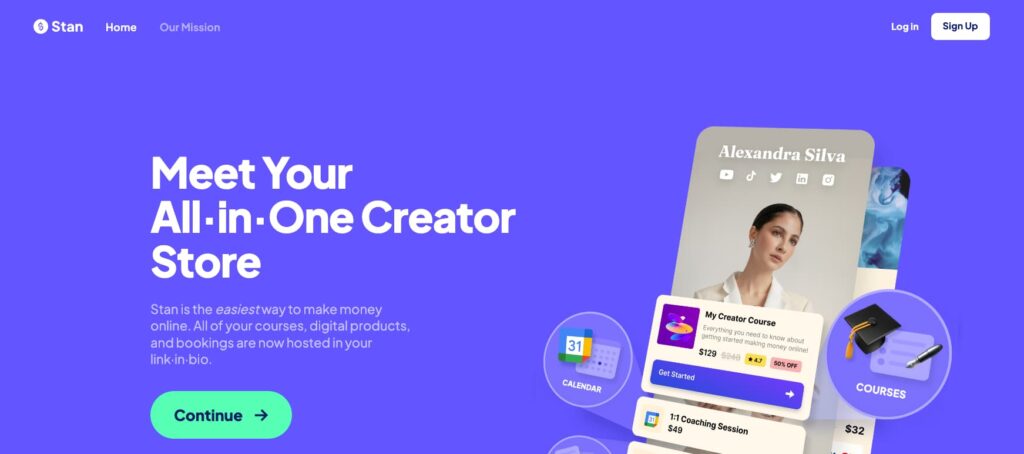
Stan.Store
Stan.Store is ideal for creators focusing on selling via Instagram and TikTok.
It’s A LOT simpler than Shopify, providing an easy setup for those new to online sales.
It’s highly visual and mobile first plus you can house anything from links, PDFs all the way to online courses savings £100s on Kajabi or Teachable.
Strategies: Given its simplicity, it’s crucial to focus on high-quality product images and compelling sales copy.
Engaging your audience through social media and directing them to your Stan.Store page can drive sales effectively.
Pros:
User-friendly, making it accessible for beginners.
Lower costs compared to more comprehensive platforms like Shopify.
Cons:
Limited customisation options.
Less visibility than larger platforms.
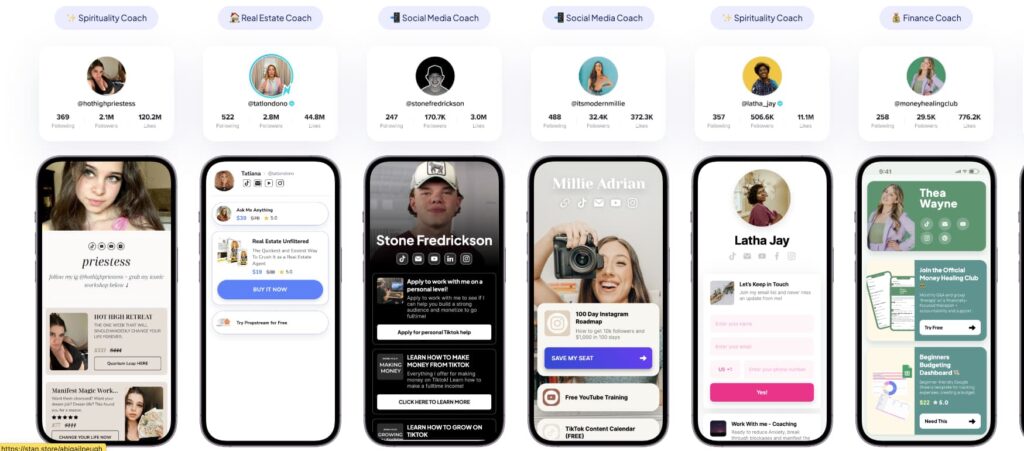
Gumroad
Gumroad is tailored for digital creators, offering a straightforward way to sell everything from e-books to software.
Its simplicity and creator-focused tools make it a popular choice.
Strategies: Leveraging Gumroad’s built-in audience can be beneficial. Engaging with the community and using Gumroad’s promotional tools can increase visibility.
Additionally, offering tiered pricing or bundle deals can attract a wider range of customers.
Pros:
Simple setup and easy to use.
Direct engagement with a community of creators and buyers.
Cons:
Limited customisation and branding options.
Fees per transaction and commissions.
Using third-party platforms for your product landing pages offers a balance of simplicity and functionality.
While platforms like Shopify provide a comprehensive suite of tools for the more tech-savvy seller, Stan.Store and Gumroad offer straightforward, user-friendly alternatives.
Your choice should align with your product type, technical expertise, and the audience you aim to reach.

Shopify
Shopify stands out for its robust e-commerce features. It’s not just a platform for product landing pages; it offers a comprehensive suite of tools to manage sales, process payments, and even integrate with social media for broader reach.
Strategies: Shopify’s analytics tools are particularly useful for understanding customer behaviour. Utilising this data can help tailor your marketing efforts more effectively.
Additionally, Shopify’s app marketplace offers numerous plugins to enhance your storefront, from SEO optimisation to email marketing integrations.
Pros:
Comprehensive e-commerce and marketing tools.
Customisable storefronts to match your brand identity.
Integrated payment processing and secure checkout.
Cons:
Monthly fees can add up, especially with added plugins.
Requires time to set up and manage effectively.
Sell digital products through email marketing
Email marketing is an invaluable strategy for selling digital products. It’s not just about sending emails; it’s about building relationships and providing value to your audience, which in turn can lead to sales.
For me, I mix this strategy in with social media and it works an absolute treat!
Growing & Nuturing Your Email List
The first step in email marketing is to grow your email list. This involves collecting email addresses from potential customers who are interested in what you have to offer.
Strategies for list building include offering freebies (like ebooks or webinars), using sign-up forms on social media, and leveraging lead magnets that provide value in exchange for email addresses.
You can also run paid ads into a landing page for your email list and generate a list that way too.
Once you have a list, it’s crucial to send engaging and relevant content. This could be updates about your products, tips related to your niche, or exclusive offers.
The key is to provide value, keeping your audience engaged and interested in what you have to say.
That way you can sell digital downloads much easier as your audience trusts you.
Personalisation is critical in email marketing. Use your subscriber’s name, and tailor your emails based on their interests or past purchases.
Segmentation, dividing your email list into specific groups, allows for more targeted and relevant messaging. This can significantly increase the effectiveness of your campaigns.
Popular Providers: ConvertKit, Mailchimp, and Beehive
Platforms like ConvertKit, Mailchimp, and Beehive are popular choices for managing email marketing campaigns.
ConvertKit is great for automation and segmentation, Mailchimp offers a user-friendly interface and diverse templates, and Beehive is known for its advanced analytics features.
Each platform has its strengths, so it’s worth exploring them to see which aligns best with your needs.
Personally, I’m a ConverKit user as it’s superior in lots of ways but it comes at a price as they’re certainly not the cheapest and when you’re starting out every penny counts.
Strategies for Selling
To effectively sell digital products via email marketing, focus on creating a sales funnel. Start with educational content to build trust, then gradually introduce your products.
Include compelling calls to action, and consider offering special deals or bonuses to your email subscribers.
Consistency in sending emails is key. Regular contact keeps you at the forefront of your audience’s mind.
Testing different aspects of your emails (like subject lines, content, and send times) can also help you understand what resonates best with your audience. For me personally testing is ABSOLUTELY vital.
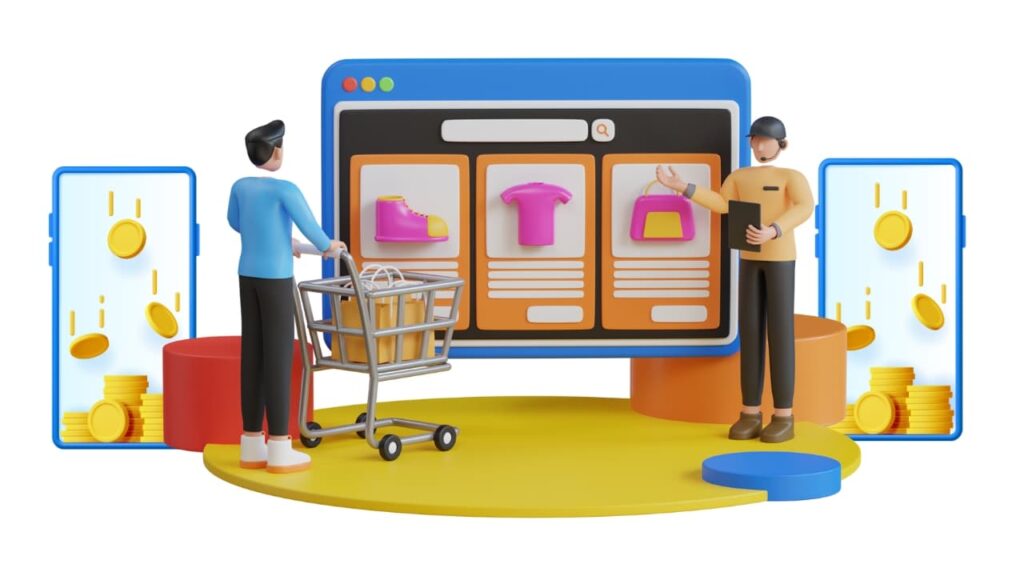
Sell digital products through course platforms
Selling digital products through course platforms taps into a specific and often highly engaged audience.
These platforms are frequented by individuals seeking to learn and invest in their education, making them ideal for selling educational digital products.
There are also plenty of other monetisation methods through courses by upselling services and push affiliate links to your course buyers too.
This can turn a £50 course into a £150 course – especially if some of those affiliate links are recurring revenue.
Understanding Course Platforms
Platforms like Udemy, Coursera, and Skillshare are popular for hosting and selling digital courses.
They cater to a wide range of topics, from technical skills to personal development.
The key is to identify the platform that aligns best with your content and target audience.
The success of your digital product on these platforms depends significantly on the quality and relevance of your content.
This involves not just the material itself, but also how you present it. Interactive elements, high-quality videos, and comprehensive course materials enhance the value of your course.
Pricing your course appropriately is crucial. Research similar courses on the platform to understand the competitive pricing landscape.
Remember, pricing too high might deter potential learners, while pricing too low could undervalue your content.
Although these platforms have their own marketing channels, actively promoting your course can significantly boost its visibility.
Utilise social media, email marketing, and other digital marketing strategies to drive traffic to your course.
Benefits of Using Course Platforms
Pros:
-
Access to an existing audience actively seeking educational content.
-
Platforms handle the technical aspects of course hosting and sales transactions.
-
Opportunities for passive income as courses can sell repeatedly.
Cons:
-
High competition with numerous courses available on the same topics.
-
Platform fees can be substantial, reducing your net earnings.
-
Limited control over branding and customer relationships, as the platform owns the customer data.
To succeed on these platforms, focus on creating high-quality, engaging content that stands out. Regular updates and additions to your course can keep it relevant and attractive to new learners.
Additionally, gathering and showcasing positive reviews from students can significantly enhance your course’s credibility and appeal.

Sell digital products through Instagram
Instagram, with its visually rich platform and vast user base, presents a unique opportunity for selling digital products.
It’s a space where compelling visuals and strategic engagement can turn followers into customers.
Learning how to sell digital products on Instagram should be a part of your strategy if you don’t have a website.
The platform is free and you can reach millions of people organically without paying for ads. The only cost is your time.
Identifying Your Product and Audience
The first step is to clearly identify the digital product you want to sell and the audience you intend to target.
This could be anything from digital art to educational courses. Understanding your audience’s interests, challenges, and behaviours is crucial for tailoring your content effectively.
Deep dive into your niche to understand what appeals to your audience. Analyse competitors, trending topics, and popular hashtags.
This research will guide you in creating content that resonates with your target audience.
Engaging with Short Reels
Instagram Reels offer a fantastic way to capture attention. Create short, 5-9 second Reels that directly address your audience’s problems or needs.
These should be eye-catching, engaging, and concise, ideally providing a quick tip or insight that showcases the value of your product.
It’s all about attention, grabbing with a hook and then leading into the caption where you can provide more value.
Utilise Instagram Stories to sell your product. Stories are temporary, which creates a sense of urgency. You can also engage with your audience directly through comments.
A great strategy is to prompt users to comment with a specific ‘WORD’ if they’re interested in your product. You can then follow up with details or direct them to a link in your bio.
To streamline and manage these interactions, consider using a tool like ManyChat.
This can help automate the process of responding to comments or direct messages, making it easier to manage leads and direct them towards your sales funnel.
Making money on Instagram with digital products requires not just great content but the rigth strategy.
Pros of Selling on Instagram
Pros:
Access to a large and diverse audience.
Highly visual platform ideal for showcasing digital products.
Instagram’s features like Reels and Stories are perfect for engaging content strategies.
Cons:
High competition; standing out requires unique and high-quality content.
Constantly changing algorithms can affect the visibility of your content.
Requires consistent engagement and content creation to maintain visibility.
Join over 1,000 others learning how to go from £0-5k with just 60 minutes work a day.
Includes everything you need to create, build and sell profitable digital products in a niche you're already passionate about.
Sell digital products through Facebook groups
Facebook Groups offer a versatile platform for selling digital products, whether by joining existing groups or creating your own.
These groups can connect you directly with specific audiences, making them ideal for targeted marketing.
Selling digital products using Facebook has been a very successful endevour in the past but now because of the algorithm changes – Facebook groups have become a lot more popular tactic.
Joining Relevant Groups
Start by identifying Facebook Groups that align with your product’s niche. Look for groups with active engagement and a significant number of members.
Understand the group dynamics and rules, especially regarding promotions and sales.
In existing groups, engage with members by answering questions and providing insights. Establish yourself as a helpful and knowledgeable member before promoting your products.
When you do promote, ensure your posts are relevant, informative, and add value to the group.
Creating Your Own Facebook Group
Alternatively, creating your own group allows you to establish a dedicated community around your brand or product. This gives you more control over the content and the rules.
Populate your group with engaging content, encourage discussions, and foster a community spirit.
You can also push people here from mailing lists, ads and even buy a Facebook group if you want these days!
Whether in your own group or others, promote your product in a way that addresses the group’s interests and needs.
Use compelling visuals and narratives that solve problems for you community which makes you a valuable go to when your products are put up.
Exclusive offers or promotions for group members can also be effective.
Utilise features like pinned posts, polls, and events for promotions. In your own group, these features can be particularly powerful for maintaining engagement and directing attention to your products.
Pros and Cons of Using Facebook Groups
Pros:
Direct access to targeted audiences.
Opportunities for building trust and loyalty.
In your own group, you have complete control over promotions.
Cons:
Requires active and consistent engagement.
In other groups, you’re bound by their rules and dynamics.
Time-consuming to manage and moderate your own group.
Sell digital products through TikTok
TikTok, known for its viral content and massive user base, can be a challenging yet rewarding platform for selling digital products.
The key lies in leveraging its unique features, such as live streaming and the recently introduced option to create and sell video courses.
Building a Community Through Live Streaming
Regularly going live on TikTok can be an effective strategy. Live sessions allow you to interact directly with your audience, build a community, and showcase your digital products in real-time.
Use these sessions to demonstrate the value of your products, answer questions, and engage with viewers on a personal level.
Selling Video Courses on TikTok
TikTok now offers the functionality to create and sell video courses directly on the platform. This feature can be particularly lucrative for digital product creators.
It allows you to package your knowledge into accessible courses and reach TikTok’s vast user base.
Strategies for Success on TikTok
-
Consistent Content Creation: Post regular content that resonates with your target audience. Use trends, hashtags, and challenges to increase your visibility.
-
Engage with Your Audience: Respond to comments, engage in TikTok duets, and use community feedback to refine your content strategy.
-
Promote Your Live Sessions: Announce your live sessions in advance. Use engaging, short videos and your other social media channels to build anticipation.
-
Leverage TikTok for Course Promotion: When you create a video course, use your TikTok content to tease the course material, highlight the benefits, and direct followers to where they can purchase the course.
Pros and Cons of Selling on TikTok
Pros:
-
Access to a large, engaged audience.
-
Live streaming creates real-time engagement and builds community.
-
The platform is ideal for creative and visually engaging content.
Cons:
-
Selling digital products can be challenging due to the platform’s entertainment-focused nature.
-
Requires consistent, high-quality content creation.
-
Building a significant following necessary for effective sales can take time.
Sell digital products through YouTube
YouTube, with its vast audience and content-driven platform, offers a fantastic opportunity for selling digital products.
It’s especially effective for building trust and growing an audience, which can then be directed to third-party landing pages or mailing lists where the actual selling happens.
Making money on YouTube now isn’t just a thing for the Mr Beasts of this world – even smaller creators with a few thousand subscribers are smashing it!
Building Trust and Audience Growth
YouTube is a platform where quality content can lead to substantial audience growth. By consistently creating videos that provide value, you can establish yourself as an authority in your niche.
This trust is essential for eventually guiding viewers to your digital products.
The key strategy is to use your YouTube content to funnel viewers to external platforms where sales occur. In your video descriptions, calls to action (CTAs), and even within the videos themselves, direct viewers to your landing pages or invite them to join your mailing list.
These platforms are where you can more directly market and sell your digital products.
Creating high-quality videos is non-negotiable on YouTube. This includes not just the content but also the production quality.
Good lighting, clear audio, and professional editing can make a significant difference in retaining viewer interest and enhancing your credibility.
Optimising Thumbnails and Titles for Click-Through Rate (CTR)
Your video thumbnails and titles are the first things potential viewers notice.
They should be compelling and clickable to stand out in a crowded space. High CTRs on your videos improve their visibility on the platform, leading to greater audience reach.
Pros and Cons of Selling on YouTube
Pros:
Access to a global audience.
Opportunity to build significant trust and authority in your niche.
Videos provide a rich, engaging way to showcase your digital products.
Cons:
Requires consistent production of high-quality content.
Building a substantial audience can take time.
Relies on directing viewers off-platform for actual sales, which can be a multi-step process.

Conclusion: How to sell digital products without a website
Selling digital products without a traditional website is not just feasible; it’s a thriving strategy in today’s digital marketplace.
By leveraging platforms like Amazon, Etsy, Instagram, and TikTok, you tap into existing audiences and capitalise on built-in marketing tools.
Whether it’s through eye-catching content on social media, engaging communities in Facebook groups, or using third-party sites for seamless transactions, the key lies in understanding and adapting to each platform’s unique offerings.
Digital downloads are highly profitable and if you start selling them remember you’ll need to have your sales tactics down if you want to see it results in money inside a bank account.
Remember, the essence of success in this realm is flexibility and innovation. Continuously refine your approach based on platform trends and audience feedback.
Embrace the dynamic digital landscape, and you’ll find that selling digital products without a website is not only possible but can also be a remarkably lucrative venture.
Share on social media
Disclaimer: Content on this page is for informational purposes and does not constitute financial advice. Always do your own research before making a financially related decision.
